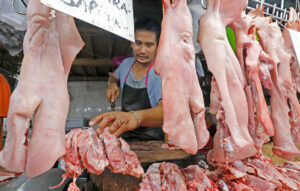THE Department of Agriculture (DA) said the maximum suggested retail price (MSRP) for pork continues to see uneven compliance, a situation which it called “alarming” in light of the large gap between retail and farmgate prices.
Citing a recent market visit, Assistant Secretary for Agribusiness, Marketing, and Consumer Affairs Genevieve E. Velicaria-Guevarra said pork belly (liempo) was selling for P420 to P440 per kilo, and pork shoulder (kasim) and pork leg/ham (pigue) P370 to P380.
“This is alarming, especially since the farmgate price of pork remains around P250 to P255,” she said in a statement.
The DA on March 10 started implementing an MSRP scheme for pork, with a price of P300 per kilo for fresh carcass… P350 a kilo for kasim and pigue, and P380 per kilo for liempo.
On April 1, the DA said the level of compliance with the pork MSRP was low at 30% after monitoring 170 stalls.
The compliance rate was 20% during the first week of implementation. It rose to 25% as of March 22.
Ms. Gueverra said pork prices should have fallen since “certain delivery costs have already decreased.”
The DA said on April 1 that the Philippine unit of Thailand’s Charoen Pokphand Foods PLC will supply 100 live hogs per day in Metro Manila at a discounted price.
Under the pilot program running from April to June, the company was set to send the hogs directly to a slaughterhouse in Caloocan.
The slaughtered hogs were expected to be processed and sold in various wet markets in the National Capital Metro Manila, Rizal and Cavite provinces.
Hog producers during consultations with Agriculture Secretary Francisco P. Tiu Laurel, Jr. have pledged to keep the farmgate price at a maximum P230 a kilo to contain pork retail prices.
The DA said in a statement on Monday that it is reviewing the pork value chain, from farmgate pricing and slaughterhouse operations to trading, retail, and consumer pricing.
The initiative seeks to identify key cost drivers at every stage and recommend policy and market interventions.
“The solution must be systemic. We are analyzing the value chain closely to determine where excessive mark-ups may be occurring and to ensure fair practices throughout the supply chain,” Ms. Guevarra said.
“The government is also exploring options to supply meat directly to the markets,” she added. — Kyle Aristophere T. Atienza

